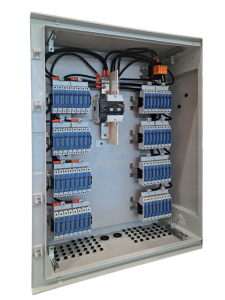
In the evolving landscape of renewable energy, photovoltaic (PV) combiner boxes play a pivotal role in enhancing the efficiency and safety of solar power systems. These specialized electrical components are fundamental in managing and optimizing the performance of solar arrays, proving to be indispensable in both residential and industrial solar installations. Understanding the functionality, characteristics, and applications of PV combiner boxes and PV array combiners is crucial for anyone involved in solar energy projects.
Understanding Photovoltaic Combiner Boxes
What They Are and Their Use: PV combiner boxes are electrical distribution boxes that aggregate the electrical output from multiple solar panels (PV modules) before feeding it into the solar inverter. In large solar installations, where combining power from several panels into a single output is necessary to increase efficiency and reduce wiring system complexity, they play an essential role.
Why They Are Used: The primary reason for using PV combiner boxes is to streamline the solar power system by consolidating the output from several panels, which simplifies the installation and maintenance processes. Additionally, they often incorporate safety features such as overcurrent protection and surge protection to safeguard the system against electrical faults and fluctuations.
Properties and Characteristics: PV combiner boxes withstand the harsh conditions typically found in outdoor environments where solar panels are installed. Manufacturers make them from durable materials that resist weather, dust, and moisture. Internally, they feature fuse links or circuit breakers for each input line, ensuring protection for each solar panel or string of panels and allowing isolation if necessary.
Delving into Photovoltaic Array Combiners
Definition and Purpose: A photovoltaic array combiner, often integrated within or associated with a PV combiner box, is a device that combines the outputs of multiple solar panel strings into a single output. Its main purpose is to facilitate the connection of multiple strings to the inverter, enhancing the system’s overall power management.
Why They Are Essential: Array combiners are critical for large-scale solar installations where managing numerous panels efficiently becomes a logistical challenge. By consolidating the outputs, array combiners minimize the number of wires leading to the inverter, reducing potential points of failure and improving system reliability.
Industry Examples and Relevance
In industrial solar farms and commercial rooftop installations, PV combiner boxes and array combiners are integral components. They not only ensure that the solar array operates at optimal efficiency but also provide a centralized point for monitoring and maintenance. For example, in a solar farm covering several acres, using combiner boxes can significantly reduce the complexity and cost of cable management while enhancing system safety and performance.
Conclusion
PV combiner boxes and photovoltaic array combiners are crucial for the efficient and safe operation of solar power systems, particularly in large-scale installations. Their ability to streamline the electrical output from multiple panels, combined with their protective features, makes them an essential component of modern solar energy solutions. As the solar industry continues to grow, the importance of these devices in achieving sustainable and reliable solar energy production cannot be understated, marking them as key elements in the advancement of renewable energy technology.

